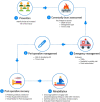Artificial intelligence in the management and treatment of burns: a systematic review
- PMID: 34423054
- PMCID: PMC8375569
- DOI: 10.1093/burnst/tkab022
Artificial intelligence in the management and treatment of burns: a systematic review
Abstract
Background: Artificial intelligence (AI) is an innovative field with potential for improving burn care. This article provides an updated review on machine learning in burn care and discusses future challenges and the role of healthcare professionals in the successful implementation of AI technologies.
Methods: A systematic search was carried out on MEDLINE, Embase and PubMed databases for English-language articles studying machine learning in burns. Articles were reviewed quantitatively and qualitatively for clinical applications, key features, algorithms, outcomes and validation methods.
Results: A total of 46 observational studies were included for review. Assessment of burn depth (n = 26), support vector machines (n = 19) and 10-fold cross-validation (n = 11) were the most common application, algorithm and validation tool used, respectively.
Conclusion: AI should be incorporated into clinical practice as an adjunct to the experienced burns provider once direct comparative analysis to current gold standards outlining its benefits and risks have been studied. Future considerations must include the development of a burn-specific common framework. Authors should use common validation tools to allow for effective comparisons. Level I/II evidence is required to produce robust proof about clinical and economic impacts.
Keywords: Artificial intelligence; Burn; Computer vision; Machine learning; Neural networks.
© The Author(s) 2021. Published by Oxford University Press.
Figures









References
-
- WHO . The global burden of disease: 2004 update. Geneva, Switzerland: World Health Organisation, 2008.
-
- Carson E. IBM Watson Health computes a pair of new solutions to improve healthcare data and security. TechRepublic, 2015.
-
- Bellman R. An introduction to artificial intelligence: Can computers think? Boston, USA: Thomson Course Technology, 1978.
LinkOut - more resources
Full Text Sources
Other Literature Sources

